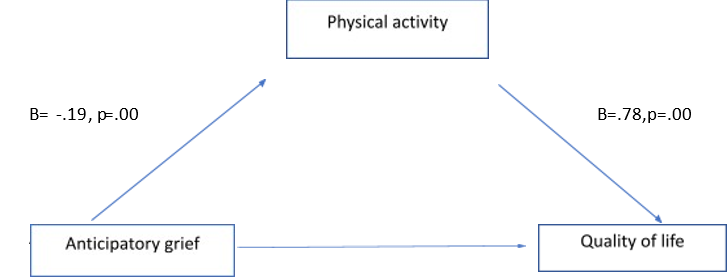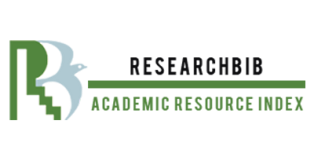Impact of Anticipatory Grief on Quality of Life among Caregivers of Thalassemia Patients: Mediating Role of Physical Activity
Keywords:
Anticipatory Grief, Quality of Life, Physical Activity, Caregivers, Thalassemia, Gender DifferencesAbstract
Caregivers of patients with chronic illness, such as thalassemia, face unique challenges in their lives. During the caretaking of the patient, caregivers face anticipatory grief due to the fear of loss. The goal of the current study was to investigate the impact of anticipatory grief on the quality of life of caregivers of thalassemia patients with the mediating role of physical activity. Differences across genders in a proposed relationship were also studied. Anticipatory grief scale (Theut et al., 1991), international physical activity questionnaire (Geneva, 1998) & quality of life scale (Flanagan, 1970), alongside the demographic sheet and written informed consent form, were employed for collecting data among 300 caregivers using cross cross-sectional survey research design that included multiple cities of Punjab. Results indicate that anticipatory grief has a significant negative relationship with quality of life and physical activity. Physical activity has a significant positive relationship with quality of life. Results also indicate that women show significantly higher levels of anticipatory grief than men. Men show a higher level of quality of life than women. The findings of the study provided strong empirical support for the predicted role of anticipatory grief on quality of life among caregivers. These findings further highlight that physical activity should be part of parents' lives to deal with grief related to the health of a child.
References
L. Axelsson, A. Alvariza, M. Holm, and K. Årestedt, “Intensity of Predeath Grief and Postdeath Grief of Family Caregivers in Palliative Care in Relation to Preparedness for Caregiving, Caregiver Burden, and Social Support,” Palliat. Med. reports, vol. 1, no. 1, pp. 191–200, Sep. 2020, doi: 10.1089/PMR.2020.0033.
E. Al-Gamal, “Quality of life and anticipatory grieving among parents living with a child with cerebral palsy,” Int. J. Nurs. Pract., vol. 19, no. 3, pp. 288–294, Jun. 2013, doi: 10.1111/IJN.12075.
A. M. Hood, A. Chaman, Y. Chen, and S. Mufti, “Psychological challenges and quality of life in Pakistani parents of children living with thalassemia,” J. Pediatr. Nurs., vol. 76, pp. 132–139, May 2024, doi: 10.1016/j.pedn.2024.02.015.
S. A’Azman, P. Sung, and R. Malhotra, “EFFECTS OF ENGAGEMENT IN PHYSICAL ACTIVITY BY INFORMAL CAREGIVERS ON THEIR QUALITY OF LIFE,” Innov. Aging, vol. 7, no. Suppl 1, p. 419, Dec. 2023, doi: 10.1093/GERONI/IGAD104.1385.
W. Agyemang-Duah, A. Abdullah, and M. W. Rosenberg, “Caregiver burden and health-related quality of life: A study of informal caregivers of older adults in Ghana,” J. Heal. Popul. Nutr., vol. 43, no. 1, pp. 1–14, Dec. 2024, doi: 10.1186/S41043-024-00509-3/TABLES/4.
A. R. Rojabi, “Exploring EFL Students’ Perception of Online Learning via Microsoft Teams: University Level in Indonesia,” English Lang. Teach. Educ. J., vol. 3, no. 2, p. 163, Sep. 2020, doi: 10.12928/ELTEJ.V3I2.2349.
A. Bibi, M. Hassan, S. U. Khan, M. O. Naeem, and L. Asnath, “Assessment of the Quality of Life of Children with Beta Thalassemia in Peshawar District: A Cross Sectional Study,” Pak. J. Med. Res., vol. 60, no. 3, pp. 121–125, Oct. 2021, Accessed: Oct. 07, 2025. [Online]. Available: https://www.pjmr.org.pk/index.php/pjmr/article/view/202
B. Biswas, N. N. Naskar, K. Basu, A. Dasgupta, R. Basu, and B. Paul, “Care-Related Quality of Life of Caregivers of Beta-Thalassemia Major Children: An Epidemiological Study in Eastern India,” J. Epidemiol. Glob. Health, vol. 10, no. 2, p. 168, Jun. 2020, doi: 10.2991/JEGH.K.200102.003.
F. D. Barber, “Effects of social support on physical activity, self-efficacy, and quality of life in adult cancer survivors and their caregivers,” Oncol. Nurs. Forum, vol. 40, no. 5, pp. 481–489, Sep. 2013, doi: 10.1188/13.ONF.481-489.
C. Y. Kustanti et al., “Anticipatory grief prevalence among caregivers of persons with a life-threatening illness: A meta-analysis,” BMJ Support. Palliat. Care, vol. 13, no. e3, pp. E1074–E1083, Feb. 2024, doi: 10.1136/BMJSPCARE-2021-003338.
J. Bilić, L. Skokandić, and L. Puljak, “Anticipatory grief and experience of providing at-home palliative care among informal caregivers of spouses in Croatia: a qualitative study,” BMC Palliat. Care, vol. 21, no. 1, pp. 1–16, Dec. 2022, doi: 10.1186/S12904-022-01093-1/TABLES/1.
C. L. Craig et al., “International physical activity questionnaire: 12-country reliability and validity,” Med. Sci. Sports Exerc., vol. 35, no. 8, pp. 1381–1395, Aug. 2003, doi: 10.1249/01.MSS.0000078924.61453.FB.
A. Coelho, M. de Brito, P. Teixeira, P. Frade, L. Barros, and A. Barbosa, “Family Caregivers’ Anticipatory Grief: A Conceptual Framework for Understanding Its Multiple Challenges,” Qual. Health Res., vol. 30, no. 5, pp. 693–703, Apr. 2020, doi: 10.1177/1049732319873330.
“(PDF) Relationship between Quality of Life and Social Support among Mothers of Children with Thalassemia.” Accessed: Oct. 07, 2025. [Online]. Available: https://www.researchgate.net/publication/352680525_Relationship_between_Quality_of_Life_and_Social_Support_among_Mothers_of_Children_with_Thalassemia
E. Ramón-Arbués et al., “Predictors of the Quality of Life of University Students: A Cross-Sectional Study,” Int. J. Environ. Res. Public Heal. 2022, Vol. 19, Page 12043, vol. 19, no. 19, p. 12043, Sep. 2022, doi: 10.3390/IJERPH191912043.
A. S. Morris, M. M. Criss, J. S. Silk, and B. J. Houltberg, “The Impact of Parenting on Emotion Regulation During Childhood and Adolescence,” Child Dev. Perspect., vol. 11, no. 4, pp. 233–238, Dec. 2017, doi: 10.1111/CDEP.12238.
M. B. Spitznagel, J. R. Anderson, B. Marchitelli, M. D. Sislak, J. Bibbo, and M. D. Carlson, “Owner quality of life, caregiver burden and anticipatory grief: How they differ, why it matters,” Vet. Rec., vol. 188, no. 9, p. no, May 2021, doi: 10.1002/VETR.74.
S. F. Fung, “Psychometric evaluation of the Warwick-Edinburgh Mental Well-being Scale (WEMWBS) with Chinese University Students,” Health Qual. Life Outcomes, vol. 17, no. 1, Mar. 2019, doi: 10.1186/S12955-019-1113-1.
M. Holm, A. Alvariza, C. J. Fürst, J. Öhlen, and K. Årestedt, “Psychometric evaluation of the anticipatory grief scale in a sample of family caregivers in the context of palliative care,” Health Qual. Life Outcomes, vol. 17, no. 1, p. 42, Mar. 2019, doi: 10.1186/S12955-019-1110-4.
C. Li et al., “Effect of caregiver burden on anticipatory grief among caregivers of elderly cancer patients: Chain mediation role of family functioning and resilience,” Front. Psychol., vol. 13, p. 1020517, Jan. 2023, doi: 10.3389/FPSYG.2022.1020517.
S. M. Loi et al., “Physical activity in caregivers: What are the psychological benefits?,” Arch. Gerontol. Geriatr., vol. 59, no. 2, pp. 204–210, 2014, doi: 10.1016/j.archger.2014.04.001.
J. Li et al., “The relationship between anticipatory grief and illness uncertainty among Chinese family caregivers of patients with advanced lung cancer: a cross-sectional study,” BMC Palliat. Care, vol. 21, no. 1, Dec. 2022, doi: 10.1186/S12904-022-00925-4.
R. Sawatzky, T. Liu-Ambrose, W. C. Miller, and C. A. Marra, “Physical activity as a mediator of the impact of chronic conditions on quality of life in older adults,” Health Qual. Life Outcomes, vol. 5, no. 1, pp. 1–11, Dec. 2007, doi: 10.1186/1477-7525-5-68/TABLES/4.
I. Shiue and M. Sand, “Quality of life in caregivers with and without chronic disease: Welsh Health Survey, 2013,” J. Public Health (Oxf)., vol. 39, no. 1, pp. 34–44, Mar. 2017, doi: 10.1093/PUBMED/FDV210.
R. Yousuf et al., “Thalassemia: A Review of the Challenges to the Families and Caregivers,” Cureus, vol. 14, no. 12, Dec. 2022, doi: 10.7759/CUREUS.32491.
H. Yasmeen, H. R. Khan, and S. Hasnain, “Exploring Caregiver Burden of Thalassemia Major Patients,” Proc. Pakistan Acad. Sci. B. Life Environ. Sci., vol. 61, no. 2, pp. 207–215, Jun. 2024, doi: 10.53560/PPASB(61-2)941.
N. Zhang, H. Li, H. Kang, Y. Wang, and Z. Zuo, “Relationship between self-disclosure and anticipatory grief in patients with advanced lung cancer: the mediation role of illness uncertainty,” Front. Psychol., vol. 14, p. 1266818, Dec. 2023, doi: 10.3389/FPSYG.2023.1266818/BIBTEX.
T. ZACHARIS, G. LYRAKOS, and V. Z. ZISI, “Physical activity and mental health in caregivers of mental ill patients in Greece,” J. Hum. Sport Exerc., vol. 15, pp. S848–S855, 2020, doi: 10.14198/JHSE.2020.15.PROC3.36.

Downloads
Published
How to Cite
Issue
Section
License
Copyright (c) 2025 50sea

This work is licensed under a Creative Commons Attribution 4.0 International License.




















